Related Research Articles

Great Barrier Island lies in the outer Hauraki Gulf, New Zealand, 100 kilometres (62 mi) north-east of central Auckland. With an area of 285 square kilometres (110 sq mi) it is the sixth-largest island of New Zealand and fourth-largest in the main chain. Its highest point, Mount Hobson, is 627 metres (2,057 ft) above sea level. The local authority is the Auckland Council.

The national parks of New Zealand are protected natural areas administered by the Department of Conservation (DOC). Although the national parks contain some of New Zealand's most beautiful scenery, the first few established were all focused on mountain scenery. Since the 1980s the focus has been on developing a more diverse representation of New Zealand landscapes. The parks are all culturally significant and many also contain historic features. Tongariro National Park is one of the World Heritage Sites that are of both cultural and natural significance, while four of the South Island national parks form Te Wahipounamu, another World Heritage Site. There are currently 13 national parks; a 14th, Te Urewera National Park, was disestablished in 2014.

Agathis australis, commonly known by its Māori name kauri, is a coniferous tree in the family Araucariaceae, found north of 38°S in the northern regions of New Zealand's North Island.

Agathis, commonly known as kauri or dammara, is a genus of 22 species of evergreen tree. The genus is part of the ancient conifer family Araucariaceae, a group once widespread during the Jurassic and Cretaceous periods, but now largely restricted to the Southern Hemisphere except for a number of extant Malesian Agathis.
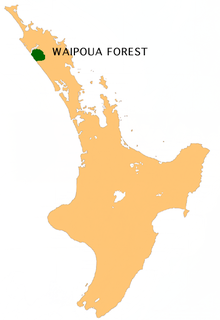
Waipoua Forest is a forest, on the west coast of the Northland Region of New Zealand's North Island. It preserves some of the best examples of kauri forest remaining in New Zealand. It is notable for having two of the largest living kauri trees, Tāne Mahuta and Te Matua Ngahere.

Kaipara Harbour is a large enclosed harbour estuary complex on the north western side of the North Island of New Zealand. The northern part of the harbour is administered by the Kaipara District and the southern part is administered by the Auckland Council. The local Māori tribe is Ngāti Whātua.

Tāne Mahuta, also called "God of the Forest", is a giant kauri tree in the Waipoua Forest of Northland Region, New Zealand. Its age is unknown but is estimated to be between 1,250 and 2,500 years. It is the largest living kauri tree known to stand today. It is named for the Māori god of forests and of birds.
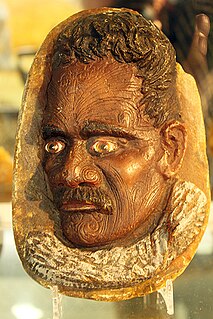
Kauri gum is a fossilised resin extracted from kauri trees, which historically had several important industrial uses. It can also be used to make crafts such as jewellery. Kauri forests once covered much of the North Island of New Zealand, before the arrival of people caused deforestation, causing several areas to revert to sand dunes, scrubs, and swamps. Even afterwards, ancient kauri fields continued to provide a source for the gum and the remaining forests.

New Zealand passports are issued to New Zealand citizens for the purpose of international travel by the Department of Internal Affairs. New Zealand has a passport possession rate of around 70% of the population and there are around 2.9 million New Zealand passports in circulation. It is ranked as one of the most powerful passports in the world.
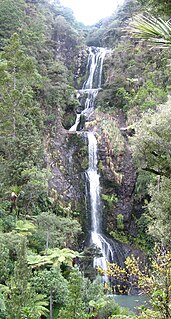
Kitekite Falls is a scenic 3-tiered waterfall near Auckland, New Zealand. The falls drop a total of 40 metres (130 ft). From the lookout on Kitekite track the falls appear even higher because there is white water running over rocks into a small pool from the upper swimming hole, then falling down into a large pool, then falling to a small pool before beginning an almost vertical descent in the final 3-tiers, making the total height closer to 80 metres (260 ft). They are located on the Glen Esk stream near Piha Beach.

Manaia is a locality on the western side of the Coromandel Peninsula of New Zealand. It lies to the east of State Highway 25, south of Coromandel and north of Tapu. The Manaia River flows from the Coromandel Range through the area and into the Manaia Harbour to the west. The harbour contains mussel farms.
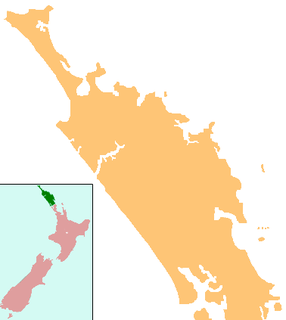
Kauri is a locality in Northland, New Zealand. State Highway 1 passes through the area. Kamo is to the south, and Hikurangi is to the north. Mt Parakiore is a volcanic dome rising 391 metres (1,283 ft) to the southwest. It is about one million years old, and part of the Harbour Fault, which also includes Mt Hikurangi near Hikurangi, and Parahaki in Whangarei.
The Siamese Kauri is a kauri tree growing in Kauri Grove, about 10 kilometres south of Coromandel township in the north-east of the North Island of New Zealand. The tree gains its name from the conjoined lower trunk that the two trees share. It grows in the Kauri Grove, one of the few remaining stands of mature kauri on the Coromandel Peninsula. It is about 500 metres off the 309 Road, and is accessed by a 30-minute walking track.
Deforestation in New Zealand has been a contentious environmental issue in the past, but native forests now have legal protection, and are not allowed to be tampered with by humans.

Kauri dieback is a forest dieback disease of the native kauri trees of New Zealand that is suspected to be caused by the oomycete Phytophthora agathidicida. Symptoms can include root rot and associated rot in a collar around the base of the tree, bleeding resin, yellowing and chlorosis of the leaves followed by extensive defoliation, and finally, death.

Langcaster Guitars is a New Zealand guitar brand founded by Dutchman Joh Lang.
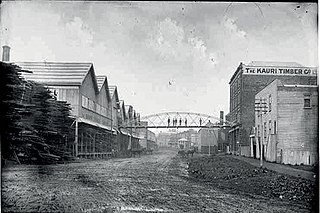
The Kauri Timber Company, Limited, (KTC) Auckland was from 1888 to 1971 a large logging and sawmilling company in New Zealand.

Trounson Kauri Park is a mainland island in the Northland Region of New Zealand. Characterised by its Kauri trees, it was named after James Trounson, who gifted the forest to the Department of Conservation.

Aotea Conservation Park is a 12,300 hectare protected area on Great Barrier Island in New Zealand's Hauraki Gulf. It was established in 2015, and comprises 43 percent of the island.

Mystic is a British-New Zealand environmental teen drama television series produced by Libertine Pictures and Slim film+television for CBBC, TVNZ and the Seven Network. Created by Amy Shindler and Beth Chalmers, it is based on Pony Club Secrets, Stacy Gregg's series of pony novels, the first of which is Mystic and the Midnight Ride (2007). Set on the fictional peninsula of Kauri Point, New Zealand, Mystic tells the story of Issie Brown and her new-found friendships with the town's teen horse riders, and their efforts to save Kauri Point from an industrial development that threatens it. It stars Macey Chipping. The series premiered on CBBC and BBC iPlayer in the UK on 14 July 2020. After the first season had aired, Mystic was renewed for second and third seasons.
References
- ↑ "Archived copy" (PDF). Archived from the original (PDF) on 2013-10-13. Retrieved 2014-05-08.
{{cite web}}: CS1 maint: archived copy as title (link)